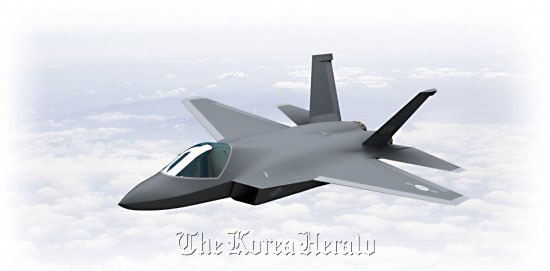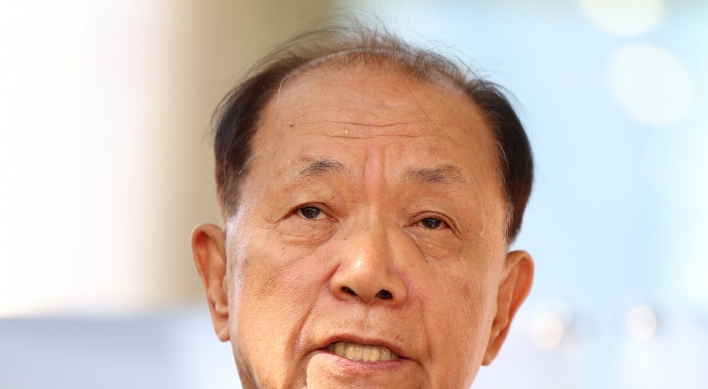Despite Seoul’s pleas, U.S. Defense Secretary Ash Carter on Thursday reaffirmed the country’s unwavering stance against a transfer of key technologies for building next-generation fighter jets, casting a cloud over South Korea’s multibillion-dollar initiative.
South Korean Defense Minister Han Min-koo met with Carter on the sidelines of President Park Geun-hye’s visit to the Pentagon in Washington, requesting he once again reconsider approving the export of four core technologies from Lockheed Martin Corp.
They are a fraction of the 25 technologies that the Maryland-based defense giant vowed to hand over on condition of the U.S. State Department’s endorsement. In September last year, the company secured a 7.3 trillion won ($6.4 billion) contract from Seoul’s Defense Acquisition Program Administration to deliver 40 F-35 radar-evading fighters to be deployed between 2018 and 2021.
Instead, the two defense chiefs agreed to form a working group to explore possibilities for cooperation to facilitate South Korea’s 18.1 trillion won project to introduce its own first KF-16-class warplanes by 2025 and deploy 120 units by 2032.
“During the meeting, Han requested a forward-looking reassessment on the technology transfer. Carter maintained the position against it, but said he will jointly explore chances for technology cooperation,” Seoul’s Defense Ministry said in a statement.
The U.S. Defense Department said, “(The two officials) agreed to establish an interagency working group to enhance cooperation on defense technology issues.”
South Korean Defense Minister Han Min-koo met with Carter on the sidelines of President Park Geun-hye’s visit to the Pentagon in Washington, requesting he once again reconsider approving the export of four core technologies from Lockheed Martin Corp.
They are a fraction of the 25 technologies that the Maryland-based defense giant vowed to hand over on condition of the U.S. State Department’s endorsement. In September last year, the company secured a 7.3 trillion won ($6.4 billion) contract from Seoul’s Defense Acquisition Program Administration to deliver 40 F-35 radar-evading fighters to be deployed between 2018 and 2021.
Instead, the two defense chiefs agreed to form a working group to explore possibilities for cooperation to facilitate South Korea’s 18.1 trillion won project to introduce its own first KF-16-class warplanes by 2025 and deploy 120 units by 2032.
“During the meeting, Han requested a forward-looking reassessment on the technology transfer. Carter maintained the position against it, but said he will jointly explore chances for technology cooperation,” Seoul’s Defense Ministry said in a statement.
The U.S. Defense Department said, “(The two officials) agreed to establish an interagency working group to enhance cooperation on defense technology issues.”

But controversy continued to simmer over the bungled handling by the ministry and DAPA of the issue, as it was widely forecast that Washington would deny an export license for the four technologies in line with their track record and given their sensitivity and sophistication.
In addition, Carter had already reiterated his position in a letter delivered a day before the talks to the South Korean Embassy in Washington, in response to the minister’s message sent last August, some four months after the decision.
The four technologies are vital to building integrated systems respectively for an active electronically scanned array radar, electro optical targeting pod, infrared search-and-track and radio frequency jammer.
Han’s appeal, which apparently had a slim chance in the first place, and his proposal for the setup of the working group were seen as an attempt by the ministry to dilute brewing criticism at home over its lack of concrete countermeasures.
To plug the perceived technical hole, ministry and DAPA officials say they will acquire the know-how from other countries, while speeding up research and development at the state-run Agency for Defense Development. Through the working group, they may be able to obtain at least part of the required software in line with the advancement of their own study, they argue, saying that the two defense chiefs reached consensus that the team will focus on assisting with the Korean Fighter Experimental program.
Yet experts have said that few other countries would be willing to transfer AESA and the overall system integration expertise in light of future competition in the export market. The ministerial agreement could be not much more than a diplomatic gesture, they said, with the Defense Department’s stance remaining steadfast and its latest statement failing to carry any hint at its resolve for technological aid.
“It’s natural to think that the U.S. government will unlikely do an about-face on a decision it has already hammered out. But as we make progress on our own R&D, they may offer some help, however partial, to boost it,” a ministry official told reporters on customary condition of anonymity.
“As the ADD has been rallying cooperation from other countries and made some headway on the four technologies with our own experts, I believe we will be able to secure the necessary algorithms, make the source codes and program them.”
By Shin Hyon-hee (heeshin@heraldcorp.com)







![[KH Explains] No more 'Michael' at Kakao Games](http://res.heraldm.com/phpwas/restmb_idxmake.php?idx=644&simg=/content/image/2024/04/28/20240428050183_0.jpg&u=20240428180321)










![[Herald Interview] Mistakes turn into blessings in street performance, director says](http://res.heraldm.com/phpwas/restmb_idxmake.php?idx=652&simg=/content/image/2024/04/28/20240428050150_0.jpg&u=20240428174656)
